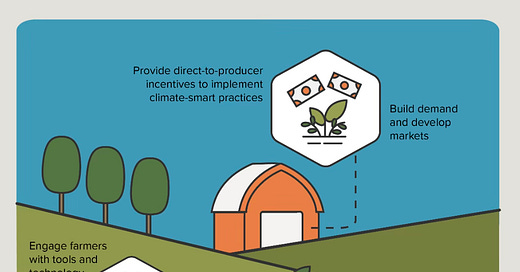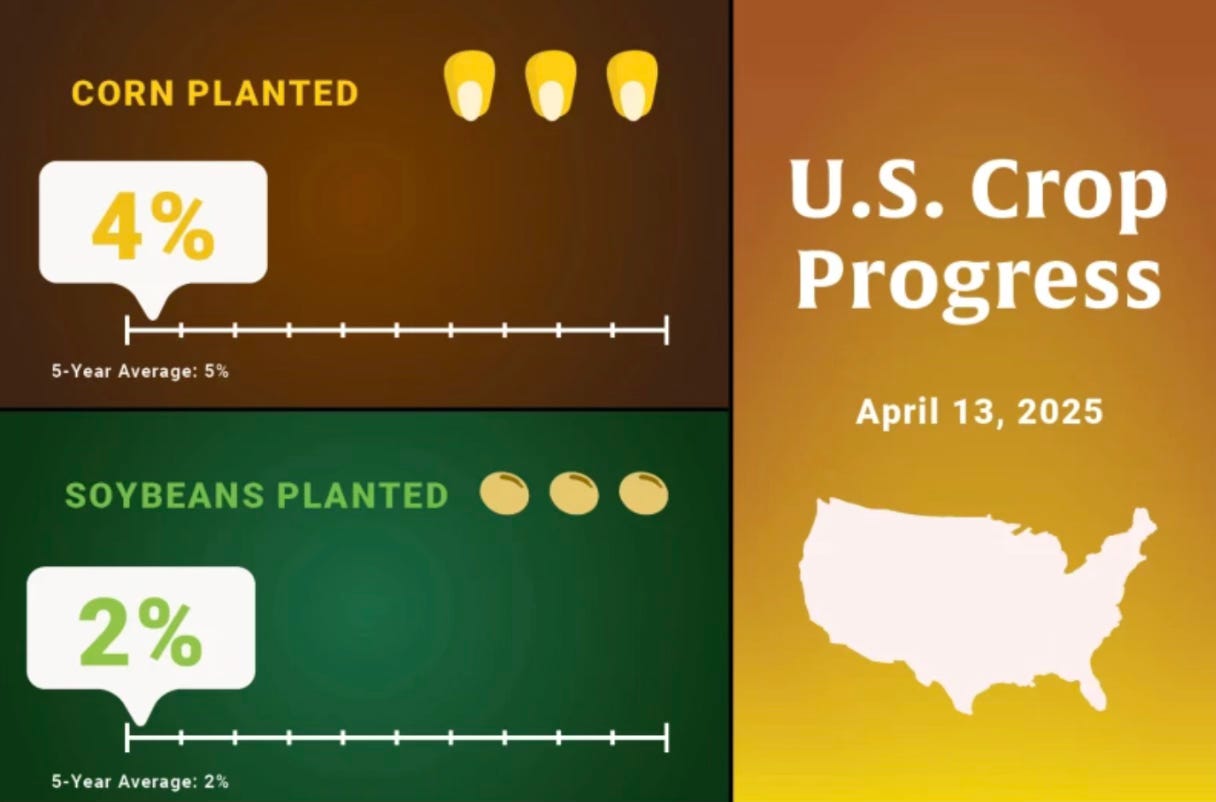Welcome back to The Aggregate Aggregation, our weekly roundup of news and publications that caught our eyes over the last week or so. You can read Volume 09 here.
Spring has sprung and new seeds are being sown—starting with the Advancing Markets for Producers initiative (AMP). But what will this grow into and how does it compare to the Partnerships for Climate Smart Commodities program it is replacing? In other news, read about potential impacts of tariffs on farmers, see how planting is going around the US, and engage in some not-so-small talk about the weather!
Let’s make it a conversation! Please share your reflections - we’d love to continue the discussion in the comments.
Digging Deep
Widespread review of funding continues, but what does this mean for farmers? On April 14, Morning Ag Clips reported that the Partnerships for Climate Smart Commodities (PCSC) has been replaced with the shiny new Advancing Markets for Producers (AMP) initiative. The Trump administration states that the PCSC overhaul will recenter the AMP program to better serve farmers. To do so, grants will be reviewed on three criteria:
Are 65% of the federal funds going to producers?
Have grant recipients enrolled one producer in the program since 12/31/24?
Have grant recipients made any payments to producers since 12/31/24?
We have some questions…
What was the PCSC program doing? The PCSC was a 3.1 billion dollar initiative to encourage farmers to adopt conservation practices to yield climate smart commodities. They partnered with 276 non profits orgs, 257 for-profit orgs, 98 colleges and universities, and 77 state, local or tribal groups as of June 2024.
Wolves Neck Center for Agriculture and the Environment, (Freeport, Maine), was using PCSC money for the program outlined above. These funds have since been frozen.
What is the immediate impact of freezing the program on farmers? The rebranding of PCSC to AMP has been felt by farmers and farming allies who are currently enrolled in PCSC programs under review. Many farmers already have projects supported by PCSC funding underway, so their options are to risk waiting for reimbursement if their program is unfrozen, or withdrawal from the program completely.
The Trump Administration seems to have a “it might be painful now but it will pay off later” approach. Do you think the reshaping of this PCSC to AMP is likely to pay off later for farmers, or is this a step in the wrong direction?
Surface Level
💱 Tariffs
Conterra: What a US Trade War Win Could Mean for Farmers (Morning Ag Clips) ‘Here’s what a ‘win’ on the tariff war could mean for the future of American agriculture: reponened and expanded export markets…rising farm incomes and rural investment…long term trade agreements and global leverage…investment in domestic infrastructure and production.’
And the flip side of that bed:
Tariff Tensions in Agriculture: What Happens if U.S. Loses? - Conterra Ag Capital (Morning Ag Clips) ‘What if this gamble doesn’t pay off? Long term loss of key export markets, oversupply at home, lower prices across the board…rising costs and declining revenues…pressure on rural lending and credit systems…stronger alliance between foreign competitors.’
🌱 Planting updates
Soybean Farmer Fine-Tunes Seeding Rates For Higher Profits (AgWeb) - ‘A seeding rate of 100,000, yielding an average of 76 bu. per acre, was the winner in 2024.’
(USDA)
More States Join Plant 2025 Thanks to a Break In the Rain (AgWeb) ‘As of April 13, USDA says 13 states have started planting corn and 10 are working on soybeans. The report calculates 4% of corn and 2% of soybeans are in the ground so far.’
2024 Perennial Impact Report Now Available (The Land Institute) - ‘The 2024 Annual Report on perennial grains adoption and impacts is now out! Check out where TLI’s perennial seeds are growing.’
⛅ Climate impacts
These 5 Top Corn-Growing States Report Extreme Drought, or Worse, as Planting Kicks Off (Successful Farming) - ‘According to the U.S. Drought Monitor published April 10, five top corn-growing states reported extreme drought, or worse.’
Warmer Temperatures Ahead, Flooded States Catch a Break (Successful Farming) - ‘As farmers look to get in the field, warming temperatures and a slow-down in precipitation may present windows for early planting.’
The Climate Crisis Is Coming For Your Favorite Foods (Saveur) ‘As the climate crisis causes rising temperatures, water scarcity, and unstable weather patterns, some of the world’s most beloved food and drink are at risk of going extinct. These five vignettes offer a glimpse of the far-reaching threats a warming planet poses to agriculture.’
🔄Everything else that caught our eyes
Teaching mental health professionals to think like a farmer | Food and Environment Reporting Network (Food and Environment Reporting Network) ‘She wanted to explore an emerging idea in psychology that farmer stress is deeply intertwined with the land. But, as a therapist, she needed a tool that could make this connection clear to farmers themselves.’ (TW: self-harm)
USDA Begins Releasing Frozen REAP Funding (National Sustainable Agriculture Coalition) ‘More than $911 million in obligated funds through REAP have been frozen. On March 26, 2025, the USDA announced previously obligated REAP funds would be released.’
Roundup at a Crossroads: Bayer Lays Out Short-Term Window for Finding a Way Forward with Glyphosate (AgWeb) ‘for Bayer to see a future of producing glyphosate, key milestones will be reached in the next six months.’
What did we miss? Drop a link to your favorite story of the week (or month, or year) in the comments. Tell us why it resonated with you!
What we’re reading
A list of sources the editors at The Aggregate check regularly for our agroecology+ news.






